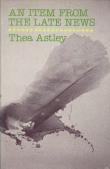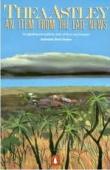'Over a fifty-year period, from 1944 to 1994, Thea Astley published a number of critical writings, including essays, newspaper articles and reviews, and short reflections and meditations on her craft. Despite a renewed interest in Astley’s work, however, most critical interrogations of her oeuvre focus on her novels, and more recently her poetry. As a result, Astley’s critical writing has not been afforded the same breadth and depth of investigation as her fiction. This lacuna is troubling, since Astley’s critical works are important not only for their insight, but for what they reveal about Astley’s self-representation, and in particular the dual identity that she embodied as both a teacher and a satirist. This article argues that these dual roles emerge clearly in Astley’s essays and in fact are inextricable from many of her works. Further, the tensions between these two personae — Astley as teacher and Astley as satirist — reveal natural overlaps with her imaginative writing, and reflect her changing ideas about fiction writing, literature, and education.' (Publication abstract)
AustLit
Latest Issues
AbstractHistoryArchive Description
'Wafer is a Bomb Age Baby. Legend has it he was born to an Australian father and a Swedish mother in Europe just before World War II, and as a young child saw his father blown apart by a bomb during the London Blitz. His own shell-shocked youth has been an aimless drifting through boarding schools, odd jobs, and hippie trails all over the world. Finally, he lands exhausted in Allbut, a small and decaying mining town somewhere in Queensland. Haunted by the modern-day myth of nuclear holocaust, Wafer seeks the perfect bomb shelter. And what better place to build your shelter than Allbut, Australia? Allbut, however, considers itself a clean and decent town, and it is soon clear that Wafer does not belong there. He is kind to Aborigines [sic], helpful to travelling strangers, and - worst of all - he doesn't drink.' (Publication summary)
Publication Details of Only Known VersionEarliest 2 Known Versions of
Other Formats
- Also braille and sound recording.
Works about this Work
-
Thea Astley’s An Item from the Late News : A Fictional Fifth Gospel
2020
single work
criticism
— Appears in: Australian Literary Studies , 29 October vol. 35 no. 2 2020;'Commentators have been quick to recognise Wafer, Item’s protagonist, as a Christ-figure, and to discuss aspects of what Roslynn Haynes perceived to be a ‘plethora of religious and universal imagery’. Another critical stream has focused on aspects of the novel’s feminism that oppose the masculinist industrial complex. This article contends that an ambiguous exploration of Christian faith and hope, conducted in a context of profound human suffering and moral failure, is central to An Item from the Late News.
'Wafer’s story offers eccentric and disorderly parallels to episodes in the Gospels before climaxing with a brutality comparable to the crucifixion. Yet the aftermath, an unrealised resurrection, connotes agnosticism. Wafer and his female ‘disciples’ Gabby and Emmie are eccentric renditions of Gospel figures who reflect their originals more closely than previous commentary has acknowledged. Above all, Item debates Christian faith through dense clusters of figures that surface throughout the text. They include Christmas; circles in place and time; the moon and the communion wafer; fire and light; darkness, hell and horned devils; Wafer’s sapphire; nakedness; and nothingness. Some clusters, notably circles with their connotations of infinity, make the transition into metaphysics. In sum, events, characterisation and figures uphold Astley’s claim, in a private letter, that she wrote An Item from the Late News ‘with a longing for Christian ideals’.' (Publication abstract)
-
Double Trouble : The Teacher/Satirist Duality in Thea Astley’s Critical Writings
2019
single work
criticism
— Appears in: Queensland Review , December vol. 26 no. 2 2019; (p. 218-231) -
Thea Astley : Writing in Overpoweringly a Male Dominated Literary World
2010
single work
criticism
— Appears in: The Indian Review of World Literature in English , July vol. 6 no. 2 2010; This paper is an attempt to explore different themes in the novels of Thea Astley.(p. 1) -
Literature in the Arid Zone
2007
single work
criticism
— Appears in: The Littoral Zone : Australian Contexts and Their Writers 2007; (p. 70-92) This chapter surveys and assesses from an ecocentric perspective some representative literary portrayals of the Australian deserts. Generally, it contrasts works that portray the desert as an alien, hostile, and undifferentiated void with works that recognise and value the biological particularities of specific desert places. It explores the literature of three dominant cultural orientations to the deserts: pastoralism, mining, and traversal. It concludes with a consideration of several multi-voiced and/or multi-genred bioregionally informed works that suggests fruitful directions for more ecocentric literary approaches. (abstract taken from The Littoral Zone) -
Thea Astley Makes Something Out of Nothing
2007
single work
criticism
— Appears in: Antipodes , June vol. 21 no. 1 2007; (p. 35-40) Paul Genoni discusses the concept of 'nothingness' in Thea Astley's writing. He concludes: 'It is in the disharmony betwen mankind and Australian space that Astley finds the impetus for many of her narratives ... And this triumph of landscape, born of the nothingness of Australian space, is the end point of many of Astley's narratives ... For Astley, it is only death that wins release from the tyranny of space and the awful pall of nothingness.'
-
Books
1982
single work
review
— Appears in: Semper , vol. 11 no. 1982; (p. 27)
— Review of An Item from the Late News 1982 single work novel -
[Review] The Bodysurfers
1985
single work
review
— Appears in: Landfall , June vol. 39 no. 2 1985; (p. 213-223)
— Review of Fly Away Peter 1982 single work novella ; The Bodysurfers 1983 selected work short story ; An Item from the Late News 1982 single work novel ; The Cure 1983 single work novel ; White Stag of Exile 1984 single work novel ; The State of the Art : The Mood of Contemporary Australia in Short Stories 1983 anthology short story ; Kewpie Doll 1984 single work novel ; The Bellarmine Jug : A Novel 1984 single work novel ; Harland's Half Acre 1984 single work novel ; Woman in a Lampshade 1983 selected work short story ; Miss Peabody's Inheritance 1983 single work novel -
Doubling Identity Problems
1982
single work
review
— Appears in: The Advertiser , 16 October 1982; (p. 29)
— Review of The Birthday Gift : A Novel 1982 single work novel ; The Home Girls 1982 selected work short story ; An Item from the Late News 1982 single work novel -
Bomb Nuts, Detectives and Prisoners
1984
single work
review
— Appears in: Island Magazine , Autumn-Winter no. 18/19 1984; (p. 40-44)
— Review of Woman in a Lampshade 1983 selected work short story ; Hostages 1983 selected work short story ; The Cure 1983 single work novel ; Headlocks & Other Stories 1983 selected work short story ; The Tournament 1983 single work novel ; The Hand That Feeds You : A Satiric Nightmare 1982 single work novel ; Stop Press 1982 single work novel ; Sister Kate : A Novel 1982 single work novel ; Were All Women Sex-Mad? And Other Stories 1982 selected work prose ; The Last Adventures of Christian Doom, Private I 1982 single work novel ; An Item from the Late News 1982 single work novel -
In the Tradition of Wake In Fright
1982
single work
review
— Appears in: The National Times , 17-23 October 1982; (p. 22)
— Review of An Item from the Late News 1982 single work novel -
Thea Astley : Exploring the Centre
2004
single work
criticism
— Appears in: Subverting the Empire : Explorers and Exploration in Australian Fiction 2004; (p. 97-144) -
Thea Astley's Failed Eden
2006
single work
criticism
— Appears in: Thea Astley's Fictional Worlds 2006; (p. 153-163) -
Thea Astley Makes Something Out of Nothing
2007
single work
criticism
— Appears in: Antipodes , June vol. 21 no. 1 2007; (p. 35-40) Paul Genoni discusses the concept of 'nothingness' in Thea Astley's writing. He concludes: 'It is in the disharmony betwen mankind and Australian space that Astley finds the impetus for many of her narratives ... And this triumph of landscape, born of the nothingness of Australian space, is the end point of many of Astley's narratives ... For Astley, it is only death that wins release from the tyranny of space and the awful pall of nothingness.' -
Literature in the Arid Zone
2007
single work
criticism
— Appears in: The Littoral Zone : Australian Contexts and Their Writers 2007; (p. 70-92) This chapter surveys and assesses from an ecocentric perspective some representative literary portrayals of the Australian deserts. Generally, it contrasts works that portray the desert as an alien, hostile, and undifferentiated void with works that recognise and value the biological particularities of specific desert places. It explores the literature of three dominant cultural orientations to the deserts: pastoralism, mining, and traversal. It concludes with a consideration of several multi-voiced and/or multi-genred bioregionally informed works that suggests fruitful directions for more ecocentric literary approaches. (abstract taken from The Littoral Zone) -
Thea Astley : Writing in Overpoweringly a Male Dominated Literary World
2010
single work
criticism
— Appears in: The Indian Review of World Literature in English , July vol. 6 no. 2 2010; This paper is an attempt to explore different themes in the novels of Thea Astley.(p. 1)
- Bush,
- Queensland,
- Country towns,
- Urban,
- 1980s





